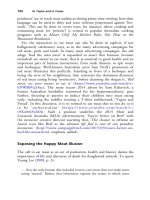The palgrave international handbook of a 236
Bạn đang xem bản rút gọn của tài liệu. Xem và tải ngay bản đầy đủ của tài liệu tại đây (25.26 KB, 1 trang )
International Trade in Animals and Animal Parts
231
and killed and then their horn removed; some are tranquilised with their
horns sewn off while they are still alive. These rhinos later die from blood loss
or shock (Milliken and Shaw 2012). Again, there are both individual and
institutional degrees of abuse in the methods of killing. Obviously, individuals suffer from being shot, bludgeoned, stabbed, cooked or mutilated, but
equally important is the systematic use of these methods to routinely inflict
injury and death in order to sate human demand for consumption. There is
little consideration for using the most humane methods possible, which
arguably should be the case if humans insist on using wildlife. Why the
abuse happens is explored in the next section.
Explanations
No single theory can effectively explain the variety and extent of animal
abuse evidenced in the legal and IWT. While it is likely that active, intentional and malicious abuse occurs in both (for example, when an animal is
specifically injured to satisfy anger or frustration), this is not commonly
identified or discussed in the wildlife trade literature, and so will not be
discussed here. Rather, given the scale of the wildlife trade and the norms
associated with the capture, consumption and use of wildlife, this section
focuses on explaining the commonplace abuses inflicted on wildlife as a
consequence of trade, as discussed above. Specifically, two notable criminolgical theories are utilised—Rational Choice Theory and Techniques of
Neutralisation—to help explain how broader societal factors influence offenders to engage in IWT. These theories are often used to explain criminal
behaviour, but they can also help to understand why people also engage in
the abuses common to the legal trade. As noted earlier, there is a fine line
between legal and illegal harm in the trade; the behaviour and motivations
are often the same, only the context changes as a result of limitations placed
on the offender. A useful starting point is to consider the people who engage
in IWT and why.
IWT Offenders and Motivations for Offending
There is no recognised profile of the IWT offender. A diverse assortment of
actors are motivated to offend: from deprived women and men who hunt,
capture and kill native wildlife, to corrupt officials taking bribes to turn a
blind eye, to organised crime groups who kill, capture, purchase and









